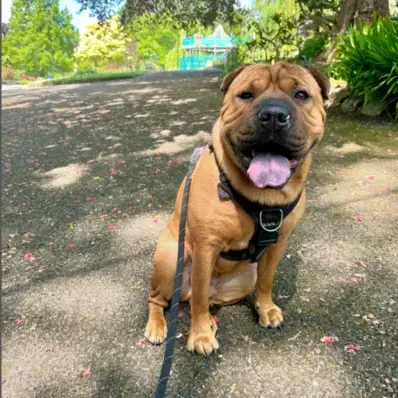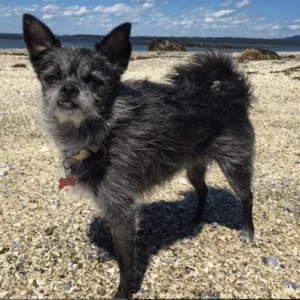Bull-Pei History/Origin
The Bull-Pei is a hybrid dog, resulting from a cross between the Bulldog and the Chinese Shar-Pei. Both breeds were initially developed as farm dogs but later became involved in dog fighting and other blood sports.
The English Bulldog has a long, somewhat obscure history. Some experts suggest it descends from Mastiffs, while others believe it’s a mix of Mastiffs and Pugs.
In the 1800s, Bulldogs were bred to be aggressive and tenacious, aiding farmers in controlling and baiting bulls—practices that also made them formidable fighters. Their skills contributed to the development of the American Pit Bull Terrier and American Staffordshire Terrier.
When dog fighting was banned in 1885, Bulldog enthusiasts began breeding for a gentler temperament, resulting in the docile English Bulldog we know today.
The Shar-Pei also has a rich and mysterious history. Originally, it assisted farmers with tasks such as hunting wild boar and guarding property. Its loose, wrinkled skin made it difficult for other dogs to grip, which was advantageous in fights.
Unfortunately, many Shar-Peis perished during the famines and political turmoil of the 1940s and 50s in China.
However, enough survived to gain recognition from the Hong Kong Kennel Club in the 1960s. Crossbreeding the Shar-Pei and Bulldog may reduce the Shar-Pei’s aggression and lengthen the Bulldog’s snout, creating a unique blend of both breeds.
Bull-Pei Personality
Bull-Peis are one of the dog breeds known for their calm and affectionate personalities. They tend to be placid and are not overly excitable, making them great companions for families and individuals alike. These dogs are happiest when surrounded by their loved ones and often prefer the comfort of home over socializing with strangers. With the right socialization and training, Bull-Pei puppies can be curious, playful, and eager to bond, bringing warmth and loyalty to any household.
- Potential Challenges
While Bull-Peis make wonderful companions, they do come with some potential challenges. Adult Bull-Peis require careful supervision around children, as the English Bulldog’s friendly nature may not be shared by the more reserved Shar-Pei. Additionally, their unique skin folds necessitate regular cleaning to prevent infections, as moisture can accumulate in the wrinkles.
Socialization is crucial; without it, they may develop shyness or wariness of strangers. Finally, consistent training is essential to manage any stubbornness that may arise, ensuring they grow into well-behaved and confident pets.
Bull-Pei Physical Appearance
Best For
The Bull-Pei is best suited for individuals or families who want a loving, loyal companion without requiring excessive exercise. They thrive in homes where they can enjoy moderate daily activity and receive plenty of affection. Ideal owners are those who can commit to grooming and maintaining their health, as well as those who appreciate a dog with a unique appearance and personality. They can adapt well to apartment living, making them great pets for various lifestyles.
Bull-Pei Gender Differences
The Bull-Pei mixed breed may inherit some of the health problems that affect both the Shar-Pei and English Bulldog. Although most Bull-Peis are generally healthy, they can be susceptible to certain health issues, making it essential to provide proper care and schedule regular veterinary check-ups.
- Hip Dysplasia: This genetic condition occurs when the hip joint doesn’t fit properly in the socket, leading to arthritis and pain. Preventive measures include selecting reputable breeders who screen for this condition and maintaining a healthy weight through appropriate diet and exercise.
- Patellar Luxation: In this condition, the kneecap dislocates or shifts out of position, which can cause limping and discomfort. Regular vet check-ups, maintaining a healthy weight, and providing moderate exercise can help prevent this issue.
- Demodicosis: This skin condition results from a mite infestation, leading to hair loss and skin irritation. To prevent it, keep your dog’s environment clean, ensure a nutritious diet to boost immunity, and schedule regular skin checks with your vet.
- Canine Gastric Torsion: A serious and potentially life-threatening condition where the stomach fills with gas and twists. Feeding smaller, more frequent meals and avoiding vigorous exercise right after eating can help prevent bloating.
- Skin Infections: Bull-Peis are prone to skin infections, especially in their folds, due to moisture buildup. Regularly cleaning and drying their skin folds, along with a balanced diet, can help prevent these infections.
- Respiratory Distress Syndrome: This condition causes breathing difficulties and can result from obesity and anatomical features. Maintaining a healthy weight and avoiding extreme temperatures can reduce the risk of respiratory issues.
Bull-Pei Health Issues
The optimal diet for a Bull-Pei should be balanced and tailored to their life stage and energy levels. This typically includes a mix of high-quality protein, healthy fats, vitamins, minerals, and fiber from vegetables such as broccoli and berries such as blueberries and strawberries.
Their diet should be designed for medium-sized dogs, as Bull-Peis can easily gain weight if overfed. It’s important to maintain a regular feeding schedule and avoid leaving food out throughout the day. Additionally, limit treats and choose high-quality dog food for the best results.
Bull-Pei Feed/Nutrition
Bull-Pei Rescue Groups
Bull-Peis need moderate exercise, making them a great fit for those who prefer a more laid-back lifestyle. They enjoy leisurely walks, relaxed play sessions, or simply spending quality time with their families. Regular exercise is important for preventing obesity, which can exacerbate existing health issues.
Keeping your Bull-Pei clean is vital for their health. Regularly check the folds of their skin to prevent infections, and clean their ears daily for debris and pests, following your vet’s recommendations. Trim your dog’s nails once or twice a month to avoid clicking against the floor, and aim to brush their teeth daily to maintain oral health. If your dog is scooting, they may need their anal glands expressed, which can be done at home or by a vet or groomer.
Bull-Peis have short coats that require minimal grooming; a weekly brushing helps distribute oils. Bathe your Bull-Pei every twelve weeks, ensuring to dry the skin folds thoroughly afterward to prevent yeast infections.
Due to their shorter coats, they aren’t well-suited for extreme weather; use a coat in winter and apply dog sunscreen to less-furred areas like the ears and nose in summer. Additionally, training your dog to stay can be useful in keeping them calm and controlled, especially during grooming or outdoor activities.
Bull-Pei Price
When considering adopting a Bull-Pei, it’s essential to remember that this new designer breed may be less commonly found in rescue organizations. Therefore, it’s often beneficial to search for rescue groups dedicated to the parent breeds, the Shar-Pei and English Bulldog. These organizations frequently have dogs in need of loving homes and can provide valuable insights into the breed’s characteristics and care.
Interesting Facts
The price of a Bull-Pei typically ranges from $800 to $2,000, depending on factors such as breeder reputation, pedigree, and location.
When looking to purchase a Bull-Pei, be prepared for a range of prices depending on the breeder and the dog’s lineage. As a designer breed, Bull-Peis may come with higher costs due to their unique characteristics and the demand for them. It’s crucial to choose a reputable breeder who adheres to ethical breeding practices, prioritizing the health and well-being of their dogs.
Bull-Pei Care and Grooming
| Male Bull-Pei Names | Female Bull-Pei Names |
| Max | Bella |
| Duke | Luna |
| Bruno | Mia |
| Rocky | Zoe |
| Oscar | Ruby |


















